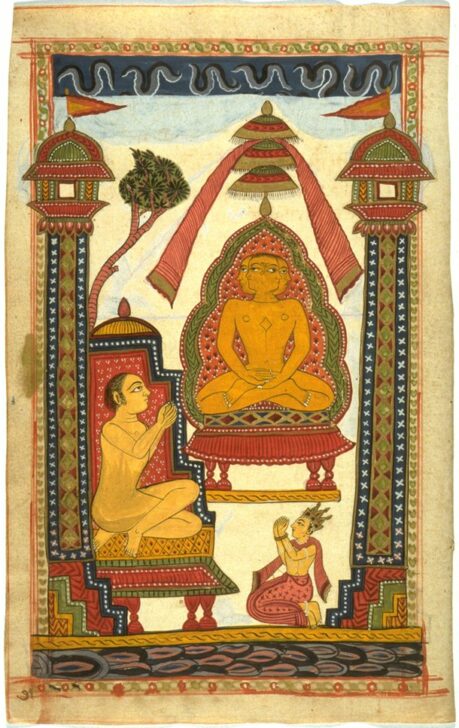Digambara Jain manuscript page: Jina venerated by a monk and a royal devotee
Artist Unknown, India, Rajasthan, Sirohi School

Description
Gallery Rotation Fall 2011
Jina and a monk in a landscape from a Digambara Jain manuscript
India, Rajasthan, Sirohi School
18th century
Ink, opaque watercolor, and gold on paper
Gift of Dr. and Mrs. Leo S. Figiel and Dr. and Mrs. Steven J. Figiel, 1975/2.172
Jina venerated by a monk and a royal devotee from a Digambara Jain manuscript
India, Rajasthan, Sirohi School
18th century
Ink, opaque watercolor, and gold on paper
Gift of Dr. and Mrs. Leo S. Figiel and Dr. and Mrs. Steven J. Figiel, 1975/2.173
In the Jain religion, book production reflects the integral relationship among the laity, monastic community, and the Jina, or enlightened Jain teacher. The dedication of sacred books for shrines is required of devotees, while commissioning a book fulfills the lay obligation of charity, and beholding a book helps the individual achieve the proper mental state for spiritual guidance. It was customary for a lay donor to commission a copy of a text for presentation to his spiritual teacher and ultimately to the temple library. Over the centuries, monastic libraries received great quantities of texts, which were employed in the instruction of monks and nuns, themselves discouraged from practicing the art of painting: one text expressly warns of the power of painting to arouse sensual feelings.
In these colorful pages, the golden-hued Jinas and the monks who venerate them are nude, identifying them as belonging to the Digambara (sky-clad) sect of Jainism. One painting illustrates a verse that likens the power of praising the Jina to destroy sins to the way the sun obliterates darkness; it shows a sun with the face of a Jina illuminating the sky. The other painting is a rare depiction of the Jina’s first preaching. It is said that the speech of the Jina is like no other and that miracles occur upon hearing it. Here the Jina is depicted with four heads, representing the miraculous ability to see in all directions at once.
Subject Matter:
This is one of 18 folios of this Digambara Jain manuscript owned by the UMMA. Other pages from the same work are in the Los Angeles County Museum of Art.
In the Jain religion, book production reflects the integral relationship among the laity, monastic community, and the Jina, or enlightened Jain teacher. The dedication of sacred books for shrines is required of devotees, while commissioning a book fulfills the lay obligation of charity, and beholding a book helps the individual achieve the proper mental state for spiritual guidance. It was customary for a lay donor to commission a copy of a text for presentation to his spiritual teacher and ultimately to the temple library. Over the centuries, monastic libraries received great quantities of texts, which were employed in the instruction of monks and nuns, themselves discouraged from practicing the art of painting: one text expressly warns of the power of painting to arouse sensual feelings.
Physical Description:
This painting is a rare depiction of the Jina’s first preaching. It is said that the speech of the Jina is like no other and that miracles occur upon hearing it. Here the Jina is depicted with four heads, representing the miraculous ability to see from all four directions at once. The golden-hued Jina and the monk who venerate a Jina are nude, identifying them as belonging to the Digambara (sky-clad) sect of Jainism.
Usage Rights:
If you are interested in using an image for a publication, please visit https://umma.umich.edu/request-image/ for more information and to fill out the online Image Rights and Reproductions Request Form.